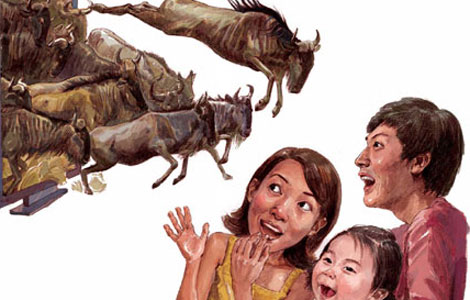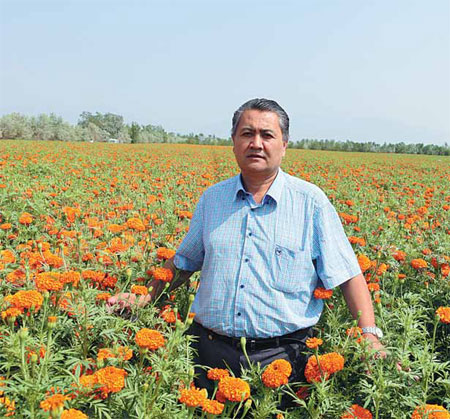Niche literary leader
Updated: 2013-08-27 06:51
By Liu Jun (China Daily)
|
||||||||
|
Author Alat Asem draws inspiration from his life in Xinjiang and experiments in combining the cream of Chinese and Uygur languages in his works. Photos Provided to China Daily |

Thanks to his rich experience, diligent studies and daring explorations, Uygur writer Alat Asem has become an eloquent spokesman for his people, Liu Jun reports.
One midnight in 1994, someone woke Alat Asem up at his office. Musa, the powerful leader of a coal mining team, wanted a drink with him.
"Brother, don't go," advised the mine's Party secretary in Ili Kazak autonomous prefecture, northwestern Xinjiang Uygur autonomous region. "What that man wants is not a drink. He has eyes inside his eyes."
Alat Asem, a Uygur official at the prefecture government, was sent to the mine to accumulate experience. He soon realized that the centuries-old mine was bogged down in power struggles.
Undaunted, he jumped in the truck and arrived at a pitch-dark village. He chewed on three chunks of fat before touching liquor - a secret that helped him survive, and socialize, in a society where drinking is a matter of reputation.
Upon the third cup, Musa collapsed.
"The new Party secretary is like a fridge - a whole box of liquor does nothing to him," Musa told his followers. "Let it be, stop playing with him."
With such obstacles gone, Alat Asem was able to fund orphans to school, befriend miners and delve into the history of the mine.
Refreshing writing
Over the years, anecdotes like these have enabled Alat Asem to create believable characters across the social strata and become a leading author in Xinjiang.
His eloquence in both Uygur and Chinese has put him in a unique position to introduce the region to the wider world.
In June, the new bilingual literary journal Chutzpah! carried his novella Sidik Golden MobOff in English, the first of his works to be introduced to an international audience.
Translator Bruce Humes, whose rendition of Chi Zijian's Last Quarter of the Moon (Harvill Secker, 2011) has won wide acclaim, added a valuable third dimension to the story in his faithful translation of the author's "earthy Xinjiang Mandarin".
"It is indeed a somewhat odd sensation to find yourself in a world populated solely by Uygurs whose innermost thoughts are described in a distinctive Mandarin with a Xinjiang feel that occasionally approaches stream-of-consciousness prose," Humes said in an e-mail interview from Antalya, Turkey, where he is studying Turkish.
The story is about Sidik, an upright but arrogant intellectual who dies of mysterious causes at 75. As his friend, the narrator, queries Sidik's foes in his search for a possible culprit, the author takes readers ever deeper into "the intestines inside the intestines" of Uygur society.
"I found Sidik a compelling character," Humes says. "While I didn't share the narrator's obsession with getting to the bottom of his death, I truly wanted to read the tale through to the end because Sidik's mania for calling a spade a spade, in the most public manner that results in massive losses of face, is recounted with great relish, imagination and detail."
Like many of Alat Asem's stories, the men all have a peculiar nickname such as Momin Back 'n' Front, Madame Munir and Father-in-Law Yalkun.
"The names are key because they are uniquely Uygur in sound and meaning, and because Sidik made a name for himself by creating insulting monikers that were too memorable to be ignored," Humes says.
Even today, when new technology is turning the world's myriad cultures into a blurry mix, Uygurs have maintained their unique way of life.
Unlike the action-packed narration commonly seen in contemporary Han Chinese writers, Alat Asem habitually breaks into long, poetic and philosophical musings in the middle of his tales.
"In the long history of the Uygurs, literature, especially poetry, has always been essential to our culture," he says. "Epics, legends and ballads permeate our expressions of daily life."
School of life
Born in 1958 as the second of four children in a family where the father worked at Ili Daily and the mother was a primary school teacher, Alat Asem's road to literary maturity was not smooth.
He spent his early years in Yutian county, Hotan prefecture, to the north of the gorgeous Kunlun Mountains in southern Xinjiang. Over the years, his work took him all over the vast region.
In 1976, the junior middle school graduate chose to go to Mengjin Commune in Huocheng county, Ili prefecture, like the urban youths sent to the countryside for re-education in the country.
The team plowed the fields until the sky was star-lit, then feasted on pilaf, danced and sang as Maria, a music teacher, played the accordion.
Two years later, he became a worker at the pressroom of Ili Daily, where the avid learner translated Uygur into Chinese in his spare time. A writing session in 1979 prompted him to pen his maiden work in Chinese about a Uygur old man.
Sometimes the best critique comes from the most unexpected corner.
"Your language is good," commented Wali, another worker at the newspaper, as they drank with some friends. "But you must write about secrets in the characters' souls: Only such things can make a true novel."
The diligent young man grasped every chance to hone his eyes and pen as he worked at various posts, including vice-mayor of Kuytun city in Ili prefecture. Today, he is deputy chairman of the Xinjiang Writers Association.
Daring explorations
While the school of life provides him with ample references for writing, literary masters like Leo Tolstoy, Victor Hugo and Lu Xun were another source of inspiration.
In his early years as a writer, Alat Asem mainly published in Chinese. This dismayed some locals who questioned his identity.
The criticism propelled him to search for the fountainhead of his Uygur traditions. Modern and contemporary poets Nimxiyit, L. Mutallip, Teyipqian and Utkur, and novelists Zordun Sabir, Akbar Mijit, Muhammat Bagrax, Ahtam Umar and Mamtimin Hoxur all inspired him.
"They all based their writing on reality and formed their own style - witty, humorous, unconstrained and lively. At the same time, they also seek after something profound," he says.
With some 10 novels and seven collections of novellas in Uygur, he earned a rightful place in Xinjiang's literary circle. However, he did not stop there.
Over the past few years, he has been experimenting in combining the cream of Chinese and Uygur languages.
"Chinese is not his mother tongue, so his Chinese writing may never reach the exquisite texture, but this is exactly why he is so attractive," Ou Ning, editor-in-chief of Chutzpah!, said in an e-mail interview.
In June 2012, Shanghai-based Wenhui Press published The Butterfly Era, a collection of Alat Asem's novellas in Chinese. When Ou compiled the 11th issue of Chutzpah! themed on Xinjiang in late 2012, he included Sidik Golden MobOff in Chinese.
"We believe his creation in Chinese writing is not in the least inferior to any active contemporary Chinese writer," Ou says.
Contact the writer at liujun@chinadaily.com.cn.
(China Daily USA 08/27/2013 page9)

 Chinese navy starts escort mission at Gulf of Aden
Chinese navy starts escort mission at Gulf of Aden
 McGrady retires, considers career in China
McGrady retires, considers career in China
 Li Na breezes into US Open second round
Li Na breezes into US Open second round
 China and India set to resume military drills
China and India set to resume military drills
 Dwight Howard, Kai Ko promote fitness in Beijing
Dwight Howard, Kai Ko promote fitness in Beijing
 DC panda cub doing well
DC panda cub doing well
 Muslim Brotherhood leaders, Mubarak face trial
Muslim Brotherhood leaders, Mubarak face trial
 Cliff diving in the city
Cliff diving in the city
Most Viewed
Editor's Picks

|

|

|

|

|

|
Today's Top News
Nation must adjust when US tapers QE
Prosecutors seek heavy punishment for Bo Xilai
Pet abuse videos prompt outrage
China joins anti-tax fraud effort
UN to contact US over spying report
Foreigners nabbed for personal info trafficking
PLA Navy heads for routine drill in W.Pacific
Antitrust 'not target' foreign firms
US Weekly

|

|








